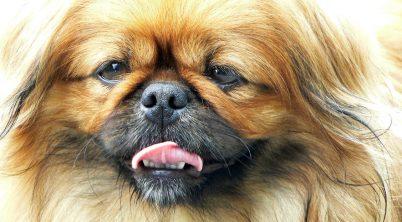The Pekingese is a toy dog breed with deep historical roots in ancient China. Known for their distinctly regal demeanor, they carry the legacy of being companions to Chinese royalty, reflecting a noble lineage often associated with Buddhist legends where they were lion-like protectors. They exhibit a confident and proud bearing, an attribute befitting dogs that were once revered as symbols of imperial status and often received the same respect as the emperors themselves.
In terms of size, the Pekingese is considered a small breed, typically standing between 6 to 9 inches tall at the shoulder. Despite their modest height, they possess a surprisingly sturdy and muscular build, giving them a more substantial appearance than their height would suggest. Adult Pekingese generally weigh between 7 to 14 pounds, with variations in weight mostly depending on their diet and activity level.
The breed is characterized by a distinctive physical appearance, from their broad, flat face and large, soulful eyes to their luxuriously long and flowing coat. Their remarkable rolling gait adds to their dignified presence. Although they may not physically resemble the lions of Buddhist lore, the Pekingese carries the spirit of a larger, more majestic creature within their compact frame, a testament to their ancient and noble heritage.
Table of Contents
How Big Do Pekingese Get?
Pekingese are known for their lion-like appearance and stature, being a toy breed that exemplifies a compact, muscular form. Despite their small size, they display a remarkable presence due to their stocky build and long-bodied structure.
Size
The Pekingese breed typically reaches a height ranging from 6 to 9 inches. They are classified as a toy breed, but they possess a solid and muscular build that contributes to their distinct, regal bearing.
Weight
In terms of weight, an adult Pekingese generally weighs between 7 to 14 pounds. It’s noteworthy that these dogs were historically referred to as ‘sleeve dogs’ in imperial China due to some being small enough to fit in the sleeve cuffs of the imperial court’s robes. These dimensions are a result of various factors, including genetics and diet. While puppies transition into solid foods, their rate of growth and eventual adult size can be approximated using a Pekingese growth chart for reference. If there are uncertainties about a dog’s lineage, a DNA test can provide more insight into their expected size and weight.
Breed Specifics
The Pekingese is a toy breed that was once revered by Chinese royalty and made a notable appearance in England during Queen Victoria’s time. This breed, recognized by the American Kennel Club, is known for being a compact and affectionate companion.
Growth and Development
When Pekingese puppies are born, they are tiny, but they experience steady growth over several months. They will typically achieve their adult size at about 9 to 12 months of age.
Growth Progression:
- Birth: Tiny, require constant care
- 2-4 Months: Rapid growth phase
- 5-9 Months: Slower growth; may reach close to adult height
- 9-12 Months: Completion of growth; attaining full weight
Pekingese Weight:
- Males: Usually range between 7 to 14 pounds
- Females: Slightly lighter than males
Once fully grown, male Pekingese may seem slightly larger compared to females due to their broader structure and heavier bone density. These toy dogs maintain a weight appropriate for their size, which contributes to their distinctive look and rolling gait.
Lifespan:
- General: A Pekingese can live between 12 to 14 years when provided proper care and nutrition.
As show dogs, Pekingese carry a regal bearing and require considerable grooming to maintain their show appearance, consistent with the standards of the American Kennel Club. This breed’s long history as a favored court companion reflects in their demeanor and physical attributes.
Ownership Considerations
When considering the ownership of a Pekingese, prospective owners must weigh various factors to ensure they can meet the needs of this distinctive breed.
Size and Companion Dynamics:
- Height: Typically stands between 6 to 9 inches tall
- Weight: Generally ranges from 7 to 14 pounds
Given their small stature, the Pekingese can be excellent companions for those living in apartments or homes with limited space. Their low height, however, means they might be prone to injury if handled too roughly or accidentally stepped on. Owners should be conscious of the dog’s presence to avoid such incidents.
Maintenance Needs:
- Coat: Requires regular grooming due to density and length
- Eyes: Need consistent cleaning to prevent infections
Maintenance is a key consideration. They possess a luxurious coat that necessitates regular grooming to prevent matting. Their prominent eyes are susceptible to irritations, calling for diligent cleaning.
Temperament and Intelligence:
- Disposition: Often independent, intelligent, and affectionate with family
- Bark: Can be vocal, a potential concern for noise-sensitive living environments
- Barking habits: Proactive training can mitigate excessive barking
The Pekingese may exhibit a rolling gait and possess a somewhat stubborn streak, but with the right approach, they can be trained effectively. Intelligence enhances their trainability, although consistency is key.
Health Considerations:
- Protuberance: Their large eyes may lead to certain health issues
- Owners should ensure regular vet checkups to maintain optical health
Ultimately, Pekingese dogs are cherished companions that require a moderate level of maintenance. Owners must be dedicated to their care, especially grooming and eye health, and should appreciate the breed’s unique personality and aesthetic charms.
* Banner photo by SheltieBoy, cropped | Some rights reserved








